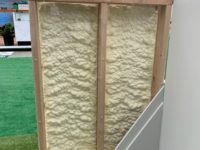Demand for multifamily housing across the U.S. has never been higher, according to data from property management and analytics platform RealPage.
With this growth, owners, developers, architects and builders are figuring out news ways to work—limiting crews on the jobsite, expediting turnover time and better budgeting for materials and services, while continuing to meet the strict code requirements when it comes to fire resistance.
Beginning around 2010, a new panel product emerged as an exciting alternate to traditional self-leveling gypsum underlayments in flooring applications and an alternate to traditional materials in fire-resistance rated wall assemblies. As the name suggests, magnesium oxide (MgO) panels are a durable cement panel product made primarily from magnesium oxide, an inorganic material that has some unique qualities that make it well suited for use in building materials.
What has led to the development and use of MgO panels in buildings? Primarily the fact that it is a promising alternative to some other traditional products and offers some compelling characteristics. One trait in particular is especially relevant to using MgO panels in multifamily buildings: fire-resistance.
Magnesuim Oxide Panels vs. Traditional Building Materials
MgO panels offer both strength and fire-resistance making them an attractive choice for use in fire-resistance rated assemblies. MgO panel products are manufactured by combining layers of glass fiber mesh to reinforce an MgO cement blend that hardens during a controlled curing process. Due to their familiar format, these construction panels can be installed by conventional framing crews that are experienced with installing exterior gypsum or wood sheathing products.
EXACOR™ MgO panels from Huber Engineered Woods have undergone a rigorous testing regimen to evaluate its use as a suitable construction material for use in subfloor, floor underlayment and exterior wall sheathing applications. Qualification and verification of code compliance for the panels is provided by the International Code Council’s Evaluation Service (ICC-ES), an independent third-party certification body. The panels exhibit structural values approaching wood sheathing with fire resistance1 similar to gypsum panels.
When it came to feedback in multifamily construction, Huber’s trusted builder relationships and architectural partners noted that the way things had been done for so long was not the way of the future. Instead of traditional building materials, MgO products such as this open the door to industry-wide innovation for multifamily and light commercial builds to help save builders time and money.
Installation—Easier Than You Think
The panels can be easily installed by framing crews familiar with installing OSB or plywood sheathing. Additionally, the panels provide a fire-resistant solution that may help reduce the number of layers needed in 2-hour fire-rated exterior wall assemblies for Type III Construction. For instance, in most conventional gypsum-based exterior wall assemblies, two layers of Type X gypsum panels are needed on either side of the wall assembly, or the addition of certain exterior siding materials is required to achieve two hours of fire-resistance on the exterior side of the assembly. The 2-hour EXACOR™ MgO exterior wall assembly2 features a single layer of MgO on the exterior side of the assembly, helping reduce material and cost of labor while still providing fire-resistance and structural performance.
And what happens if a fire breaks out? Testing has shown that MgO panels are capable of resisting the spread of flames, don’t burn as quickly as wood sheathing panels and do not shrink or crack when exposed to extreme heat, helping to resist flame and hot gasses from penetrating into wall cavities. All this to say it can better allow for building occupants to exit a structure safely in a time of crisis when used as part of a fire-resistance rated assembly.
Putting MgO to the Test
MgO panels are designed to provide a more streamlined approach to fire-resistant performance for exterior wall assemblies, especially when compared to traditional building materials. When used in fire-resistance rated assemblies, products such as EXACOR™ panels perform three main functions: preventing the spread of flame across the surface of the sheathing, resisting fire from burning through to other materials, and providing structural performance for shear and braced walls. Many larger multifamily projects are designed as Construction Type III buildings in accordance with the International Building Code (IBC). Type III Construction allows you to build taller structures with a larger footprint than other smaller multifamily projects that would typically fall into Construction Type V. To build larger and taller buildings, Type III Construction requires increased consideration for fire-resistance and further scrutiny regarding material selection for exterior walls. To ensure exterior sheathing products such as MgO can be used in this type of application, the panels must undergo a battery of fire related testing.
Flame Spread
The standard measurement for flame spread is the Steiner Tunnel Test, or the ASTM E84 test. It measures the ability of a material to resist the spread of flame across the surface of the material.
In this test, building materials are placed in a 25-foot tunnel, and an air draft is introduced to attempt to pull flames across the surface. Data collected during the test is used to calculate a metric, known as the Flame Spread Index (FSI), which indicates that material’s flame spread resistance. Materials are categorized into three classification based on their FSI: Class A, B and C. Materials with a Class A rating (FSI ≤25) are considered to be very good at resisting the spread of flame, whereas Class C materials allow for rapid flame spread.
In addition to requiring a Class A flame spread rating, the building code also requires that certain building materials extend the Steiner Tunnel test by an additional 20 minutes to be considered for use as sheathing in exterior walls of Type III Construction. During this 20-minute period, the flame front cannot progress 10.5ft or greater beyond the centerline of the burner at any point during the test.
EXACOR™ panels have an FSI rating of zero as measured by ASTM E84, meaning they do not allow flames to spread across the surface at all, and did not experience any progression of flame when the test was extended for the additional 20-minute period.
Fire Endurance and Structural Integrity
As important as it is for a MgO sheathing panel to resist flame spread, it’s meaningless if the rest of the wall assembly burns and loses its structural integrity. That’s why the ASTM E119 test (also referred to as ANSI-UL 263) is also important.
ASTM E119 is a fire endurance test that evaluates the entire assembly, including interior wall board, framing, insulation and exterior sheathing. It’s a rigorous test in which assemblies are subjected to a standardized controlled fire with temperatures reaching in excess of 1600 degrees Fahrenheit. For load bearing wall assemblies, this test is used to evaluate the duration of time for which the assembly can both contain a fire and maintain its structural integrity. Meaning an in-service design load is applied to the assembly and is then subjected to a fire on one side. The assembly must be able to maintain that design load throughout the duration of the fire test.
Building codes prescribe a certain level of fire-resistance that is required depending on the type of assembly and the Construction Type. Fire-resistance requirements are given in hours, such as 1, 2, 3 or 4 hours and are often referred to as a “fire-resistance rating” or simply a “fire-rating.” The fire-rating is how long an assembly is expected to maintain its structural integrity, providing time to allow occupants to exit safely.
Generally, exterior load bearing walls in Construction Types III and VA are required to have 2-hours and 1-hour of fire-resistance respectively. These fire-resistance ratings are required to be applied to the interior face of the assembly, meaning the exterior wall needs to be able to resist a fire burning on the inside of the building for the specified time. In addition to these requirements, certain projects such as those where exterior walls are close to an adjacent building or lot line, may require the exterior side of the wall assembly to be rated for fire-resistance as well.
Exterior wall assemblies that carry an additional rating for fire exposure on the exterior side, often require additional layers of exterior sheathing or require specific types of siding materials to be used to achieve the rating. Fire-resistance rated wall assemblies with EXACOR™ have been thoughtfully designed to have fire-resistance ratings applied to both sides of the wall. In some cases, exterior fire-resistance ratings can be achieved with a single-layer of sheathing and without the need for specific claddings types to meet the fire-resistance rating, giving designers a greater degree of freedom for siding selection.
Currently, EXACOR™ has 1-hour and 2-hour fire rated assemblies and continue to test more assemblies and material combinations.
Flame Spread Along Building Façade
Another critical issue can be fire spread across the exterior face of a building. Model codes require structures of Construction Type I-IV that are greater than 40 feet in height above grade plane and contain combustible materials, to be tested in accordance with NFPA 285. The NFPA 285 test evaluates fire propagation characteristics of exterior wall assemblies.
The exterior wall assembly to be evaluated is constructed with all of the materials that are expected to be used in the actual construction of the wall assembly in the field, to include interior wallboard, insulation, framing, exterior sheathing, water-resistive/air barriers, exterior insulation and siding as well as window opening. The constructed exterior wall assembly is affixed to a two-story test structure that features an upper compartment and a lower compartment. The test starts by igniting a fire in the lower compartment. Five minutes into the test an additional burner is placed at the window to simulate a room fire that has now spread out of the window exposing the exterior wall assembly to the fire.
The goal of an NFPA 285 compliant assembly, is to attempt to prevent a fire that has started on a lower level of a building from spreading fire along the façade and affecting the rest of the structure. At the same time, the assembly must also be able to prevent fire from being able to spread into the upper compartment on the interior face of the assembly.
It is important to note that this is an assembly test and the presence of a singular product in that assembly does not necessarily mean that assembly is compliant with NFPA 285, as the success of the assembly could be impacted by the other materials present. Designers and builders should ensure that their exterior walls meet the assembly requirements for passing the test.
Some MgO panels have been evaluated for use with various siding and water-resistive barrier combinations to ensure compliance with NFPA 285.
Fire Resistance & Flexibility
The building codes prescribe fire performance requirements of materials and assemblies to ensure the safety of people who live and work in the buildings in which they are used. Material selection can play an important part in meeting fire-resistance requirements. New and innovative materials, such as MgO panels, can help meet these requirements while streamlining the assembly details.
What this means for architects and building developers is that they have more flexibility and designers have more choices when selecting materials for exterior cladding and other parts of exterior wall assemblies.
References
1 EXACOR panels may be used in specific published fire-resistant-rated assemblies as tested in accordance with ASTM E119/ANSI UL 263. Follow published fire-resistance-rated assembly requirements and consult local building codes and designer of record for fire-resistant design requirements.
2 According to ICC-ES ESL-1290.



.jpg?height=200&t=1634674970&width=200)